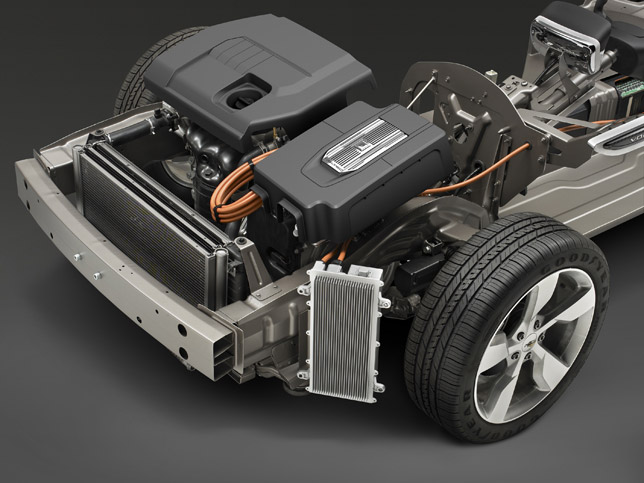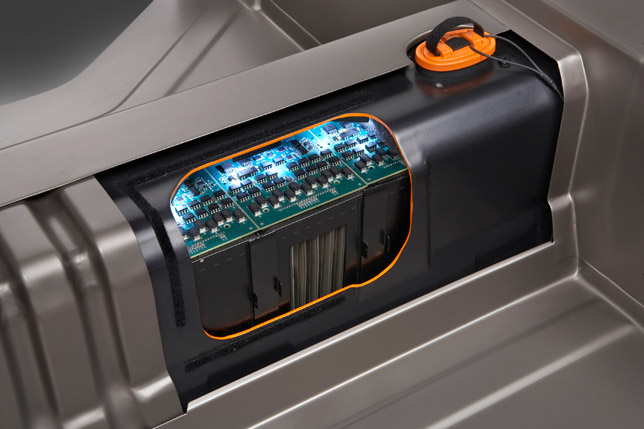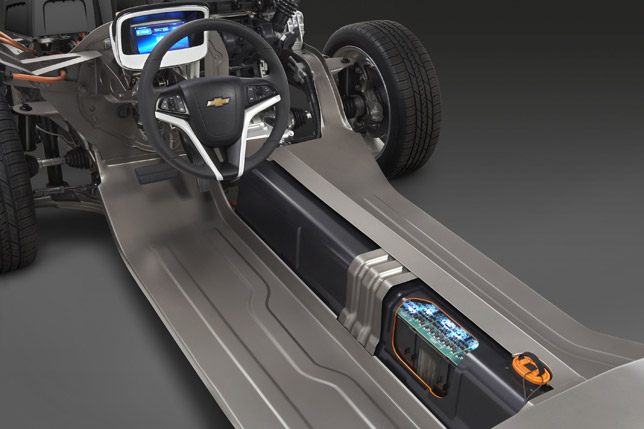Chevrolet Volt Battery Packs Will Be Manufactured by General Motors in the United States
The Chevrolet Volt, an extended-range electric vehicle that delivers up to 40 miles of gasoline- and emissions-free electric driving, will use battery packs manufactured in the United States by General Motors, Chairman and CEO Rick Wagoner announced at the North American International Auto Show.
GM will establish the first lithium-ion battery pack manufacturing facility operated by a major automaker in the United States to produce the Volt's battery pack system. It consists of lithium-ion cells that are grouped into modules, along with other key battery components.
The plant will be located in Michigan, subject to negotiations with state and local government authorities. Facility preparation will begin in early 2009, with production tooling to be installed mid-year and output starting in 2010.
"The design, development and production of advanced batteries must be a core competency for GM, and we've been rapidly building our capability and resources to support this direction," Wagoner said. "This is a further demonstration of our commitment to the electrification of the automobile and to the Chevrolet Volt - a commitment that now totals more than $1 billion."
The Volt's lithium-ion battery cells will be supplied by LG Chem. Compact Power Inc., a subsidiary of LG Chem based in Troy, Mich., will build battery packs for Volt prototype vehicles until GM's battery facility is operational. A joint engineering contract with Compact Power and LG Chem also has been signed to further expedite the development of the Volt's lithium-ion battery technology.

GM has been testing battery packs for the Volt, powered by cells from LG Chem, for the past 16 months. These tests - both on the road and in the lab - have provided invaluable insight into lithium-ion battery technology.
"Our selection of LG Chem was based on performance, production readiness, efficiency, durability and LG Chem's demonstrated track record of exceptional quality," Wagoner said. "At GM, we believe the technical strengths of LG Chem, combined with our own engineering and manufacturing expertise, will help position us as a key player in the development of electrically driven vehicles today and in the future."

GM's advanced battery strategy
"Our announcements are part of a comprehensive advanced battery strategy for GM that is expanding along two pathways," Wagoner said. "First, we're identifying core competencies - such as battery research, development and assembly - and integrating these fundamentals into our product development and manufacturing operations. We believe this will become a competitive advantage for GM, and will be critical to GM's long-term success. Secondly, we're building a roster of battery suppliers and academic experts from around the globe, and leveraging their specialized abilities to develop battery chemistries and cell designs, as well as future automotive battery engineers."
Key elements of GM's advanced battery strategy include:
* Opening the largest automotive battery lab in the United States (31,000 square feet / 3,251 square meters) that will be capable of testing new energy storage system technologies, as well as lithium-ion and nickel-metal hydride batteries, to accelerate the domestic development of advanced battery technology and lead GM's network of existing labs in Honeoye Falls, N.Y.; Warren, Mich.; Torrance, Calif.; and Mainz-Kastel, Germany. This new battery lab will be located in Michigan, subject to final negotiations with state and local authorities
* Continuing to ramp-up "in-house" battery-development capability by increasing the staff of GM's global hybrid, electric vehicle and advanced battery organization to several hundred engineers in 2009, including more than 200 currently dedicated to advanced battery technologies
* Joining with the University of Michigan to create a new automotive advanced battery lab in Ann Arbor, Mich., and a specialized curriculum within U of M's College of Engineering to develop automotive battery engineers
* Continuing to grow and establish a robust lineup of battery suppliers for cell development and manufacturing and battery integration expertise, with companies such as LG Chem, A123Systems, Hitachi Ltd., Compact Power and Cobasys
* Collaborating with government organizations and industry consortia, such as the U.S. Department of Energy; United States Council for Automotive Research; the United States Advanced Battery Consortium LLC; and Electric Power Research Institute to advance the development of hybrids, plug-ins and electric vehicles, and related electric infrastructure to support those vehicles

Energy alternatives and advanced technologies that reduce dependency on petroleum, improve fuel economy and reduce emissions are the keys to developing sustainable transportation. GM is pursuing several options to best meet the varied needs of customers around the world - from advanced gasoline, diesel and biofuel technology to electrically assisted vehicles such as hybrids, plug-in hybrids and - ultimately -electrically driven extended-range electric vehicles and hydrogen fuel cell vehicles. GM believes that electrically driven vehicles, based on battery and hydrogen fuel cell technology, offer the best long-term solution for providing sustainable personal transportation.
In June 2008, the GM Board of Directors approved the Chevrolet Volt program and Voltec™ propulsion system for production starting in late 2010. For trips of up to 40 miles, the Volt is powered by electricity from the grid and stored in its lithium-ion battery pack. Beyond 40 miles, a small engine-generator creates additional electricity to extend the range of the Volt several hundred additional miles. The development of the Volt's 16 kWh T-shaped lithium-ion battery, which is roughly 6 feet long (1.8 meters) and weighs nearly 400 pounds (181 kg), is key to the Volt's success. The production-intent design was revealed in September 2008.





